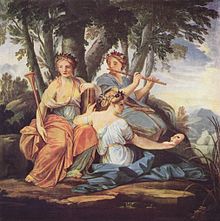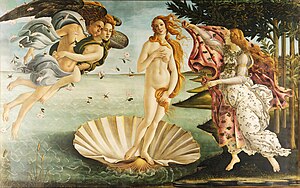Paintings as Architectural styles
Sometimes, art and architecture follow the same flows and trends, but somehow they are never studied together. So I asked myself: did they change in the same way? Or its just a matter of the ages the creators were living in? Let’s make a quick study in order to find a solution to that.
Classic style: «Las musas Clío, Euterpe y Talía»

The classical civilizations of ancient Greece and Rome took architecture very seriously. According to the Roman architect Vitruvius, all structures should be strong, useful and beautiful, a combination called Vitruvian Triad. This was achieved mathematically with the golden ratio, which is found everywhere in nature. The golden proportions of the human body were the basis of the ideal proportions of a classical temple.
This tendency was born in the university city of Bologna, in a cultured environment that sought a reality that was more intellectual than the manic moods. Therefore, in painting, they do not choose to express naturalism, but rather to express an ideal beauty. It was, therefore, a credible and noble art, which did not fall into vulgarity and left great silence.
Romanic: «Madonna»

The novel is primarily an architectural art. Painting and sculpture are generally designed as organic parts of the building.
Each era is characterized by a kind of construction that in a way sums up the spirit of the times. Romanesque architecture is represented by large religious buildings (temple and monastery) and feudal castles.
The novel that concerns all arts, in the painting of its subjects, very repeated, almost exclusively religious and framed in an essential didactic function in view of the general illiteracy, besides incorporating allegorical content accessible only to an initiated minority (the monastic elite andthe high clergy).
Gothic: «Lamentación sobre Cristo muerto»

Gothic architecture is a style that values height and shows a complex and sensitive aesthetic. He placed special emphasis on the structural lightness and lighting of the fleets inside the buildings. It originated from the Romanesque but stopped resisting the massive volumes and the poor interior lighting in its churches. It was basically developed in religious architecture (monasteries and churches) and had its greatest success in the construction of large cathedrals, a secular task in which competing cities competed; although civil architecture (palaces, commercial markets, town halls, universities, hospitals and private residences in the new city bourgeoisie) and military architecture (castles and city walls) were also important.
In painting, there are so many things in common with architecture because it focuses on new philosophical and religious trends, it tended to approximate the representation of religious characters on a more human than divine level, so that they could show feelings and emotions, break the hieratics and Romancce formalism.
Renasance: «El nacimiento de Venus»

The architectural idea of the Renaissance is beauty and perfection, which is based on a mathematically oriented rationalism, so that the theory of proportions tries to reduce the proportions of the human body to the common denominator. mathematical laws of basic geometric shapes. , such as perimeter and square, and express them in generally valid proportional rules.
In painting, the form of expression is figurative, naturalistic and idealized, which gives the beautiful and proportionate human figure great importance. Naked is developed that allows the artist to show his knowledge in the representation of anatomy. In addition, the composition is organized according to elementary geometric patterns.
Barroque: «La fragua de Vulcano»

Modern: «La noche estrellada»

The modern style has a particularly decorative and aesthetic character based on nature, flora and fauna. He tries to face a more academic style and rejects electronic religion and false historiography in the late nineteenth century and tries to bring art to all walks of life. It is a bourgeois and urban style, which seeks rich and sophisticated forms, combining function and beauty, striving to create a happy and optimistic city in the face of the success of industrialization, but demanding products of better quality than those offered by the industry today. moment.
Modernism influenced the painting in the same way as the paintings were inspired by nature and the extensive use of elements of natural origin, but mainly with vegetables and rounded forms of an organic species that intertwine with the main motif.
Contemporaneus: «Ecce homo»
